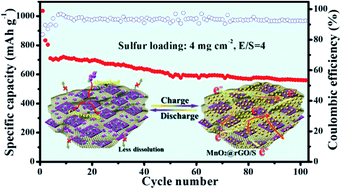Manganese dioxide nanosheet functionalized reduced graphene oxide as a compacted cathode matrix for lithium–sulphur batteries with a low electrolyte/sulphur ratio†
Abstract
Lithium–sulphur (Li–S) batteries are interesting due to their high theoretical capacity and energy density. However, their commercial implementation is impeded by the lack of suitable sulphur cathodes that have high electrochemical stability and high sulphur loading using a low electrolyte/sulphur ratio. In this work, reduced graphene oxide functionalized with MnO2 nanosheets was demonstrated as a sulphur cathode (MnO2@rGO/S). The high polarity of the MnO2 nanosheets grown on the rGO surface is beneficial for the uniform distribution of sulphur, providing access to Li+ and immobilizing polysulfides in the cathode region. This leads to an improved electrolyte wettability, promoted sulphur utilization and enhanced reaction kinetics. As a result, the obtained cathode enables superior cyclability over 500 cycles with a capacity fading rate of only 0.034% per cycle. Moreover, a sulphur content of 70 wt% with an electrolyte/sulphur ratio of 4 μL mg−1 is achieved, and the volumetric energy density at the cell level is more than 188 W h L−1 at 1.34 mA cm−2 using Li-metal as the anode. It is comparable and even superior to those of recently reported carbon-based sulphur batteries.



 Please wait while we load your content...
Please wait while we load your content...